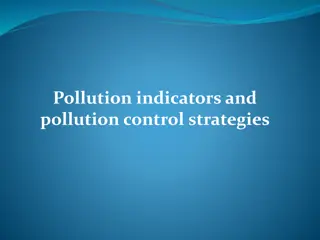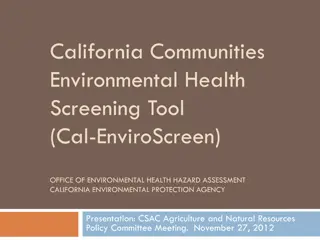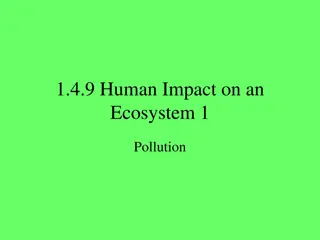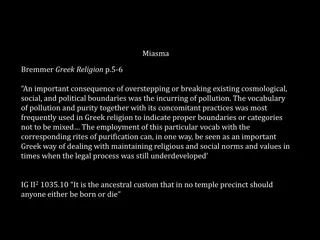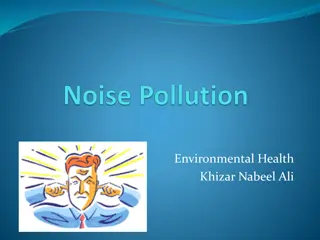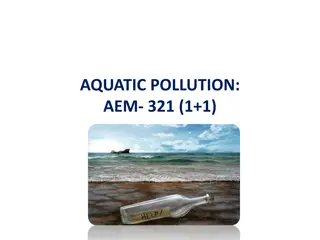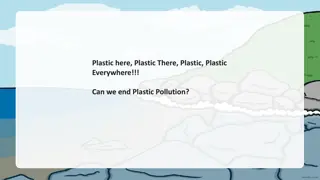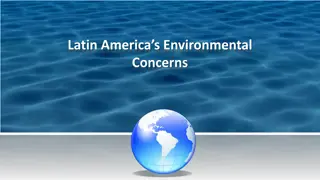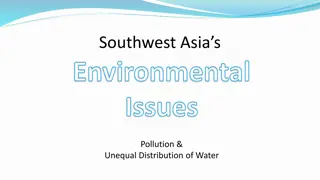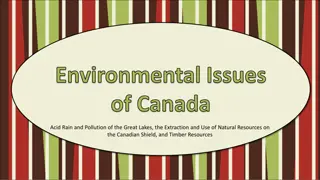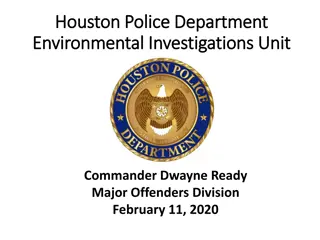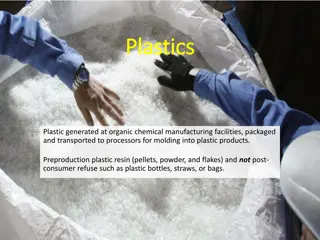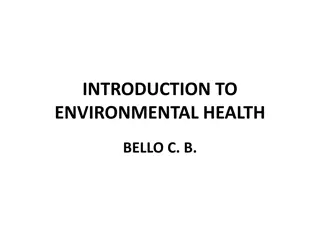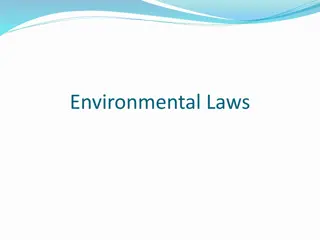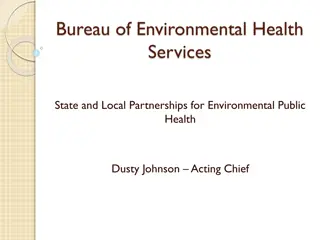Understanding the Components and Types of Environmental Pollution
The environment comprises abiotic and biotic elements, including the atmosphere, hydrosphere, lithosphere, and biosphere. Different types of pollution, such as air, water, land/soil, noise, and thermal pollution, pose significant threats to human health and the environment. Awareness of these pollutants and their sources is crucial for effective environmental management and conservation efforts.
Download Presentation

Please find below an Image/Link to download the presentation.
The content on the website is provided AS IS for your information and personal use only. It may not be sold, licensed, or shared on other websites without obtaining consent from the author. Download presentation by click this link. If you encounter any issues during the download, it is possible that the publisher has removed the file from their server.
E N D
Presentation Transcript
INTRODUCTION Environment may be consider as our surroundings which includes everything around us, i.e. the non-living (abiotic) and living (biotic) environment. The abiotic environment consists of air, water and soil while the biotic environment includes all the living organisms like plants, animals & microorganisms. The environment is composed of four basic components
Atmosphere - The atmosphere is basically derived from the earth itself by various chemical and biochemical reactions. The major components of the atmosphere include the gases nitrogen, oxygen, argon, carbon dioxide, water vapors suspended particulates. The atmosphere is vertically divided into four Layers troposphere, stratosphere, thermosphere. This division is mainly based on the increase in the temperature. 1. mesosphere, and Hydrosphere - The hydrosphere primarily consists of the water on the earth s surface. hydrosphere includes oceans, seas, rivers, streams, lakes, reservoirs and polar ice caps. Water is the most abundant substance on the earth s surface which may be present as ice, liquid and vapor. Approximately, 71% of the earth s surface is covered with water, mainly in the form of oceans. 2.
Lithosphere - The outer boundary layer of the solid earth on which the continents and the ocean basins rest constitutes the lithosphere. 3/10th of the total surface of the earth. 3. approximately Biosphere - The biosphere comprises of all the zones on earth in which life is present. The biosphere is very vast, and for the sake of understanding, it is divided into smaller units namely ecosystems. An ecosystem may be considered as the smallest unit of biosphere that possesses the requisite characteristics to sustain life e.g., ponds, seas, deserts, cities. 4.
Types of Pollution The environmental pollution may be categorized into six major groups: Air/atmosphere pollution can cause harm to humans and the environment is known as an air pollutant. Pollutants can be in the form of solid particles, liquid droplets, or gases. In addition, they may be natural or man-made. Six major air pollutants - Carbon monoxide (CO), Ozone (O3), Nitrogen dioxide (NO2), Sulfur oxides (SOx), Carbon dioxide (CO2 ), Lead (Pb). Water pollution - Water pollution cause when chemicals or dangerous foreign substances are introduced to water including chemicals, sewage, pesticides and fertilizers from agricultural runoff or metals like lead or mercury. A substance in the air that 1. 2.
Land/soil pollution - Land can become polluted by household garbage and by industrial waste. Use of fertilizers, pesticides, insecticides, dumping of solid waste, deforestation, and pollution due to urbanization and other anthropogenic pollution. Noise pollution - Humans can't see or smell noise pollution it still affects the environment. Research shown that there are direct links between noise and health including stress-related illnesses, High Blood Pressure, speech interference, hearing loss , emotional complications such as aggression, mental depression and annoyance. Thermal pollution - Sudden increase or decrease in temperature of a natural body of water, which may be ocean, lake, river or pond by human influence. 3. substances causes soil 4. 5.
Radioactive pollution -Radioactive pollution is the pollution caused on account of the release of radioactive substances or radiations in the environment. Radiations are mainly of two types: Non-ionizing radiations: The electromagnetic waves at the longer wavelength of the spectrum ranging from near infra- red rays to radio waves constitute non-ionizing radiations. Ionizing radiations: when ionizing radiations pass from a medium, they ionize the atoms and molecules of the medium. Noise pollution - Humans can't see or smell noise pollution it still affects the environment. Research shown that there are direct links between noise and health including stress-related illnesses, High Blood Pressure, speech interference, hearing loss , emotional complications such as aggression, mental depression and annoyance. 6. 7.
Nature of Pollutants - The pollutants that occur in the environment may be chemical, biological and physical in their nature. Chemical pollutants - Gaseous pollutants like sulfur dioxide, nitrogen dioxide, toxic metals, pesticides, herbicides, hydrocarbons, toxins, acidic substances, carcinogens. 10. Biological pollutants - biological origin. 11. Physical pollutants - Heat (thermal), sound, odours, radiation and radioactive substances. 8. 9. organisms, products of Methods for the measurement of Pollution Direct measurements - Measuring temperature in several locations along the length of a river or at different times of the year.
Take systematically to determine changes Measuring nitrate levels/ammonia levels/ chloride levels as an indication of nutrient overload Measuring TSS or TDS as an indication of material entering the lake or stream Indirect measurements- Monitor the effects of the pollutants on other factors - Dissolved oxygen. BOD - The measure of the amount of dissolved oxygen that is used by aerobic bacteria to break down the organic matter in a specific volume of water. The greater the organic matter (sewage, agricultural run- off, fertilizer, etc.) the higher the BOD. If DO level is less than BOD, it is possible that there is not enough oxygen to sustain larger organisms like fish. The process of accumulating large amount of organic matter is called eutrophication. a baseline measurement and then monitor
Measuring BOD Measure DO on day 1 again on Day 5 samples should be kept at 20oC in the dark during that time Presence or absence of indicator species. Factors Controlling BOD and DO Amajor source of DO comes from the atmosphere Moving water is able to dissolve more oxygen If DO equals or exceeds the BOD, the system is considered healthy. Temperature is a major factor BOD is affected by respiration or lack there of by microorganisms and by increase in organic matter, waste and sewage
Biotic index - Indirect measurement of organisms in the ecosystem Indicator or index species Species by their abundance or absence indicate the level of pollution in an ecosystem The diversity of species can indicate the quality and overall health of the system. measurement involves monitoring and Important indicators Fish Bottom fauna Algae Bacteria
Comparing the relative abundance of stoneflies, mayflies, and caddis flies to midge and sludge worms Comparison of diatoms to blue-green algae Measuring coliform levels can indicate the presence of sewage dumping in the ecosystem Overall diversity of the system is the best indicator presence is better than absence Methodology of environmental management the problem solving approach Environmental management refers to the management of modern human society with, and its impact on, the environment. Because natural resources are finite and limited, they can only support a certain population within any species.
Characteristics of Environmental Management 1. It is often used as a generic term . 2. It supports sustainable development . 3. It shows opportunities & also addresses threats & problems . 4. It calls for a multidisciplinary approach . The best approach to environmental management is an integrated approach in which all the components of the environment are taken into consideration and its proper management, as a whole, is done. While doing so, the following aspects should be taken into account:
Perception and awareness of environment: 1. Source of perception and awareness Level of perception Role of perception in environmental planning. Environmental education and training: 2. At school, college and university levels Through media At research and training institutes. Resource management: 3. Classification of natural resources, Survey and evaluation of eco-resources, Conservation of energy, mineral, forest, soil and water resources
Proper utilization of human resources. Environmental impact assessment: 4. Assessment of present conditions, Assessment of the impact of industrial and technological developments, Assessment of the efforts done for eco-balance Development of eco-friendly techniques. Control pollution: Purification of degraded environment Pollution control Monitoring Forecasting of natural hazards and to minimize the losses. over environmental degradation and 5.
There are two approaches of managing the environment. 1) Preservative approach - According to this approach man should not disturb the natural system and should adapt to it. But this is not possible because for all types of developmental activities he will have to use nature and its components, resulting in Eco imbalance of varied intensity. 2) Conservative approach - The conservative approach is that there should not be overexploitation of nature and conservation of natural resources is essential for sustainable development. The various approaches developed for the environmental management are: Ad hoc approach- developed in reaction to a specific situation.
Problem-solving approach: for identification of problems and needs and implement solutions. Systems approach: such as ecosystem, agro-ecosystem, etc. Regional approach: based on ecological zones such as watershed, river basin, coastal zone, command area development, island etc. Specialist discipline approach, often adopted by professionals for air, water and land management, urban management, tourism management, and environmental health. Voluntary sector approach encouraged and supported by NGOs. Commercial approach: for environmental management for business.
Thank You Thank You




